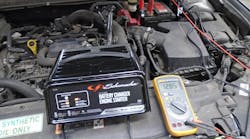While hand tools may seem very “basic” that doesn’t make proper usage or safety practices surrounding them any less important. According to research done by the Occupational Safety and Health Administration (OSHA), almost 10 percent of all workplace injuries are caused by hand tools. Having to take time off of work because of a hammer-smashed finger or a hospital trip to get stitches isn’t ideal, so here are a few hand tool tips to help keep everyone in the shop safe.
1. Maintain your tools
There are many ways to help keep your tools in peak condition, including keeping them clean, sharp, and defect-free. At the end of the day, if your tools are covered in grease, oil, etc. clean them off, so they’re ready to go for the next day. Failure to do this could lead to an insecure grip on a tool resulting in injury to yourself or to a coworker.
Keep knives and scissors sharp — a dull blade is actually more hazardous than a sharp one.
Also, be sure to check your tools for chips, splinters, or other possible defects before and after use. Using even a partially broken tool could break the tool further and potentially result in damage to the vehicle you’re working on, yourself, or others around you.
2. Use the correct tools
Though it seems obvious, make sure to use the correct tool for the job at hand. Not only can this help with the ease and duration of a task, but it can keep you, the user, safer. Though it may seem easier to use whatever tool is on hand as a striking tool or to use your screwdriver as a pry bar or chisel, if the tool wasn’t designed to perform those actions, then chances are something may go wrong.
It’s also important to understand how to use a tool before putting it into action. Using a tool you haven’t been trained to use is a recipe for disaster. If you’re uncertain, consult the shop owner, a fellow technician, or the manufacturer’s operating manual.
3. Wear PPE
Even when correctly maintaining and using your tools, there’s still a risk of injury, so PPE is highly recommended. Depending on your environment and the task at hand, specific safety procedures will vary. Check tool manufacturer labels and warnings, any posted signs and placards, and your shop’s safety manual for safety instructions to ensure you’re wearing the right gear.


